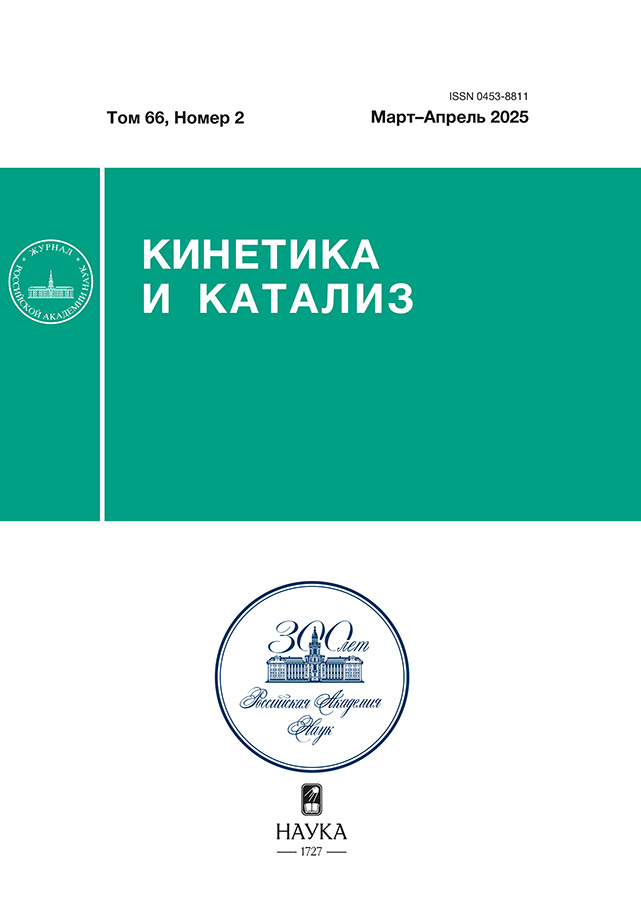XPS study of [Ir(COD)Cl]2–L–SiO2 catalytic system
- Autores: Nartova A.V.1, Donskikh K.G.1, Kvon R.I.1, Kovtunova L.M.1,2, Dmitrachkov A.M.1, Skovpin I.V.2, Koptyug I.V.2, Bukhtiyarov V.I.1
-
Afiliações:
- Boreskov Institute of Catalysis SB RAS
- International Tomography Center SB RAS
- Edição: Volume 66, Nº 2 (2025)
- Páginas: 136-146
- Seção: VIII Международная научная школа-конференция молодых ученых “Катализ: от науки к промышленности” (30 сентября–3 октября 2024 г., Томск)
- URL: https://cardiosomatics.ru/0453-8811/article/view/689888
- DOI: https://doi.org/10.31857/S0453881125020075
- EDN: https://elibrary.ru/SKXOLJ
- ID: 689888
Citar
Texto integral
Resumo
The X-ray photoelectron spectroscopy (XPS) and nuclear magnetic resonance (NMR) spectroscopy were used to study the features of anchoring of the [Ir2(COD)2Cl2] complex on the surface of modified silica gel L–SiO2 (where L is NC5H5–CH2–CH2–, N(CH3)2–CH2–CH2–CH2–, NH2–C3H6–) depending on the nature of the linker and the conditions of preparation of the systems. The catalytic activity was tested in reactions of gas-phase selective hydrogenation of propylene with parahydrogen (p-H2). According to the XPS data, a single-site iridium catalyst is prepared in all cases. Analysis of the XPS spectra indicates the possibility of anchoring the complex through one of the Ir atoms while preserving the dimer. It was shown that at different durations of interaction of the iridium complex solution with modified NH2–C3H6– silica gel approximately the same amount of the complex is anchored, but the nature of the complex coordination changes. For the sample obtained by long-term interaction of the complex solution with the modified support (24 h), a high increase in the NMR signal was observed at 60°C, while in the case of the sample prepared by short-term interaction (1 h), the signal increased with a rise in temperature to 80°C.
Texto integral
Sobre autores
A. Nartova
Boreskov Institute of Catalysis SB RAS
Autor responsável pela correspondência
Email: nartova@catalysis.ru
Rússia, Acad. Lavrentieva ave., 5, Novosibirsk, 630090
K. Donskikh
Boreskov Institute of Catalysis SB RAS
Email: nartova@catalysis.ru
Rússia, Acad. Lavrentieva ave., 5, Novosibirsk, 630090
R. Kvon
Boreskov Institute of Catalysis SB RAS
Email: nartova@catalysis.ru
Rússia, Acad. Lavrentieva ave., 5, Novosibirsk, 630090
L. Kovtunova
Boreskov Institute of Catalysis SB RAS; International Tomography Center SB RAS
Email: nartova@catalysis.ru
Rússia, Acad. Lavrentieva ave., 5, Novosibirsk, 630090; Institutskaya str., 3A, Novosibirsk, 630090
A. Dmitrachkov
Boreskov Institute of Catalysis SB RAS
Email: nartova@catalysis.ru
Rússia, Acad. Lavrentieva ave., 5, Novosibirsk, 630090
I. Skovpin
International Tomography Center SB RAS
Email: nartova@catalysis.ru
Rússia, Institutskaya str., 3A, Novosibirsk, 630090
I. Koptyug
International Tomography Center SB RAS
Email: nartova@catalysis.ru
Rússia, Institutskaya str., 3A, Novosibirsk, 630090
V. Bukhtiyarov
Boreskov Institute of Catalysis SB RAS
Email: nartova@catalysis.ru
Rússia, Acad. Lavrentieva ave., 5, Novosibirsk, 630090
Bibliografia
- The Handbook of Homogeneous Hydrogenation. J.G. de Vries, C.J. Elsevier, Eds, Wiley-VCH: Weinheim, 2007.
- Skovpin I.V., Kovtunova L.M., Nartova A.V., Kvon R.I., Bukhtiyarov V.I., Koptyug I.V. // Catal. Sci. Technol. 2022. V. 12. P. 3247. https://doi.org/10.1039/D1CY02258J
- Encyclopedia of Reagents for Organic Synthesis. Wetcott S.A., Parthasaraty S., Gilder P.G., Colacot T.J. Eds., John Wiley & Sons: Hoboken, NJ, 2018.
- Hesp K.D., Stradiotto M. // Org. Lett. 2009. V. 11. P. 1449. https://doi.org/10.1021/ol900174f
- Motokura K., Ding S., Usui K., Kong Y. // ACS Catal. 2021. V. 11. P. 11985. https://doi.org/10.1021/acscatal.1c03426
- Skovpin I.V., Sviyazov S.V., Burueva D.B., Kovtunova L.M., Nartova A.V., Kvon R.I., Bukhtiyarov V.I., Koptyug I.V. // Dokl. Phys. Chem. 2023. V. 512. P. 149. https://doi.org/10.1134/S0012501623600237
- Lazaro G., Iglesias M., Femandez-Alvarez F.J., Sanz Miguel P.J., Perez-Torrente J.J., Oro L.A. // ChemCatChem. 2013. V. 5. P. 1133. https://doi.org/10.1002/cctc.201200309
- Zhang S., Wang H., Li M., Han J., Liu X., Gong J. // Chem. Sci. 2017. V. 8. P. 4489. https://doi.org/10.1039/c7sc00713b
- Esfandiari M., Havaei G., Zahiri S., Mohammadnezhad G. // Coord. Chem. Rev. 2022. V. 472. 214778. https://doi.org/10.1016/j.ccr.2022.214778
- Nartova A.V., Kvon R.I, Kovtunova L.M, Skovpin I.V., Koptyug I.V., Bukhtiyarov V.I. // Int. J. Mol. Sci. 2023. V. 24. P. 15643. https://doi.org/10.3390/ijms242115643
- Skovpin I.V., Burueva D.B., Kovtunova L.M., Nartova A.V, Kvon R.I., Bukhtiyarov V.I., Koptyug I.V. // Appl. Magn. Reson. 2024. V. 55. P. 1275. https://doi.org/10.1007/s00723-024-01660-0
- Buljubasich L., Franzoni M.B., Münnemann K. // Top. Curr. Chem. 2013. V. 338. P. 33. https://doi.org/10.1007/128_2013_420
- Gutmann T, Ratajczyk T., Xu Y., Breitzke H., Grunberg A., Dillenberger S., Bommerich U., Trantzschel T., Bernarding J., Buntkowsky G. // Solid State NMR. 2010. V. 38. P. 90. https://doi.org/10.1016/j.ssnmr.2011.03.001
- Duckett S.B., Mewis R.E. // Acc. Chem. Res. 2012. V. 45. P. 1247. https://doi.org/10.1016/S0079-6565(98)00027-2
- Bowers C.R., Weitekamp D.P. // J. Am. Chem. Soc. 1987. V. 109. P. 5541. https://doi.org/10.1021/ja00252a049
- Bouchard L.-S., Kovtunov K., Burt S., Anwar M., Koptyug I., Sagdeev R., Pines A. // Angew. Chem. Int. Ed. Engl. 2007.V. 46. P. 4064. https://doi.org/10.1002/anie.200700830
- Mondloch J.E, Wang Q., Frenkel A.I., Finke R.G. // J. Am. Chem. Soc. 2010. V. 132. P. 9701. https://doi.org/10.1021/ja1030062
- Moulder J.F., Stckle W.F., Sobol P.E., Bomben K.D. Handbook of X-ray Photoelectron Spectroscopy. J. Chastain Eds. Eden Prairie. MN: Perkin-Elmer, 1992.
- Surface Analysis by Auger and X-ray Photoelectron Spectroscopy. D. Briggs, J.T. Grant, Eds. IM Publications and SurfaceSpectra Limited, Cromwell Press, Trowbridge, UK, 2003.
- Fernando N.K., Cairns A.B., Murray C.A., Thompson A.L., Dickerson J.L., Garman E.F., Ahmed N., Ratcliff L.E., Regoutz A. // J. Phys. Chem. 2021. V. 125. P. 7473. https://doi.org/10.1021/acs.jpca.1c05759
- Using XPS PEAK Version 4.1. http://sun.phy.cuhk.edu.hk/ ~surface/XPSPEAK/XPSPEAKusersguide.doc [Electronic resource]
- Lea A.S., Swanson K.R., Haack J.N., Castle J.E., Tougaard S., Baer D.R. // Surf. Interf. Anal. 2010. V. 42. P. 1061. https://doi.org/10.1002/sia.3304
- Nartova A.V., Kvon R.I., Kovtunova L.M., Dmitrachkov A.M., Skovpin I.V., Bukhtiyarov V.I. // Kinet. Catal. 2024. V. 65. № 2. P. 202. https://doi.org/10.1134/s0023158423601213
- Groom C.R., Bruno I.J., Lightfoot M.P., Ward S.C. // Acta Cryst. 2016. V. 72. P. 171. https://doi.org/10.1107/S2052520616003954
Arquivos suplementares















